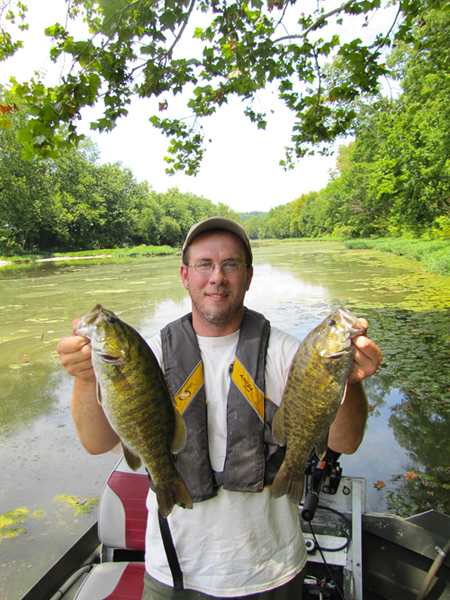
BY Lee McClellan
This is the first installment of a series of articles titled “Fall Fishing Festival” profiling the productive fishing on Kentucky’s lakes, rivers and streams in fall.
FRANKFORT, Ky. – If you are a river or stream angler, this past spring and summer has filled your belly with enough frustration to pull your hair out by the handful.
Mother Nature greeted every stream fishing trip you planned for the upcoming weekend by rudely parking a heavy thunderstorm in the headwaters of the intended stream two days before the trip. A torrent of glutinous, rust colored water followed the monsoon, looking like the stream flowed from the bottom of a hog pen. Instead of fun fishing, it became time to mow the yard instead.
The recent dry spell means streams are finally low and clear. The smallmouth bass that live in them are hungry.

“It is the ideal situation right now on our Kentucky streams,” said David Baker, stream biologist for the Kentucky Department of Fish and Wildlife Resources. “Streams are at their prime now. On lakes, the water is hot and the fish lethargic. Stream smallmouths are feeding like crazy.”
The low and clear water puts smallmouth bass at an advantage over their prey, which they exploit with abandon. “There are more stable flows now in our streams,” said Jeff Ross, assistant director of fisheries for Kentucky Fish and Wildlife. “The baitfish and smallmouth bass are in closer proximity. They are feeding up now with the shorter days to prepare for winter.”
During a recent trip to a central Kentucky stream, Baker caught over 20 smallmouth bass longer than 12 inches. It takes about five years for a stream smallmouth bass to reach a foot in length.
“This time of year, smallmouths are schooled up,” Baker said. “If you catch one, spend some time in that spot. The low water concentrates the smallmouths and you can catch several from the same pool.”
Topwater lures draw incredibly savage strikes from stream smallmouths in September. The banana or cigar-shaped 3- to 4-inch long topwater lures worked with the “walk the dog” retrieve are deadly right now. Fish these lures across flowing shoals, beside undercut banks and in the tailout water above and below riffles.
“Don’t spend too much time fishing soft-plastic lures really slow right now,” Baker said. He prefers searching for smallmouth schools by throwing lures that cover water such as 1/8-ounce white and silver spinnerbaits, floating/diving minnow-shaped jerkbaits in shad colors and smaller minnow-shaped crankbaits.
“The flat bedrock areas are holding fish,” Baker said. “I don’t usually fish flat, boring bedrock, but crayfish and minnows are holding on them right now.”
He said the minnows he’s witnessed in streams are roughly three to four inches long. Lures should match that size.
Stealth is important since streams are flowing at their lowest level since last winter. “The fish can see you coming,” Baker said. “Make long casts and stay off the areas you plan to fish.”
Under-utilized smallmouth streams course all across Kentucky. If a local flow has water at least waist deep and a rocky bottom along with pools and riffles, it likely holds smallmouth bass.
The Kentucky Fish and Wildlife website at fw.ky.gov has two excellent resources for Kentucky anglers to locate and learn more about the smallmouth fishing streams in their area. Click on the “Fishing and Boating” tab, then on the “Where to Fish” tab and then on the printable “Kentucky Smallmouth Streams” brochure.
You may also click on the Blue Water Trails tab on the same screen and locate two dozen streams profiled that provide public access points, floating mileages, printable maps and fishing information. Many of the streams featured in the series contain good smallmouth bass populations.
The great stream smallmouth fishing continues well into fall. Once water temperatures fall below 50 degrees, usually by mid-November, the fishing slows drastically.
There is long way to go before now and then. Get out in the next few weeks and enjoy the best stream smallmouth fishing of the year.
Author Lee McClellan is an award-winning associate editor for Kentucky Afield magazine, the official publication of the Kentucky Department of Fish and Wildlife Resources. He is a life-long hunter and angler, with a passion for smallmouth bass fishing.
(Editors: Please email lee.mcclellan@ky.gov for photos.)
-30-
The Kentucky Department of Fish and Wildlife Resources manages, regulates, enforces and promotes responsible use of all fish and wildlife species, their habitats, public wildlife areas and waterways for the benefit of those resources and for public enjoyment. Kentucky Fish and Wildlife is an agency of the Tourism, Arts and Heritage Cabinet. For more information on the department, visit our website at fw.ky.gov.


Hey, awesome article! Super inspiring. I really like going fishing (and|&) outdoor stuff. Thank you so much.